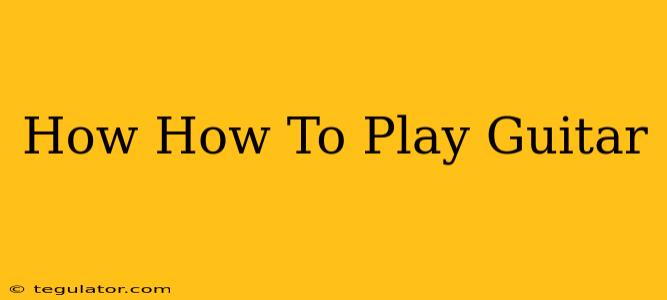So, you want to learn how to play the guitar? That's fantastic! The guitar is a rewarding instrument, offering a lifetime of musical expression. This comprehensive guide will walk you through the essential steps to get you started on your musical journey. Whether you dream of strumming campfire classics or shredding solos, this guide will provide you with the foundational knowledge you need.
Getting Started: Essential Gear
Before you can start strumming, you'll need a few essential items:
- A Guitar: Acoustic guitars are a popular choice for beginners due to their simplicity and affordability. Consider a smaller-bodied guitar if you have smaller hands. Electric guitars require an amplifier, which adds to the initial cost.
- A Guitar Pick (Plec): Experiment with different thicknesses to find what feels comfortable. A medium-gauge pick is a good starting point.
- A Tuner: Keeping your guitar in tune is crucial. You can use a clip-on tuner, a smartphone app, or an online tuner.
- A Guitar Strap (for electric/acoustic): This allows you to play comfortably while standing.
Learning Basic Chords
Mastering basic chords is fundamental to playing guitar. Start with these easy chords:
- G Major: A relatively easy chord to master for beginners.
- C Major: Another fundamental chord, forming the basis of many songs.
- D Major: Slightly more challenging, but essential for expanding your repertoire.
- Em (E minor): Introduces the concept of minor chords, adding emotional depth to your playing.
- Am (A minor): Another common minor chord that works well with many other chords.
How to Practice Chords
- Finger Placement: Accurate finger placement is crucial for clean chord changes. Use chord diagrams (easily found online) as a reference.
- Regular Practice: Even 15-30 minutes of daily practice will make a huge difference.
- Listen Carefully: Pay attention to the sound you're producing. Are all the strings ringing clearly?
Mastering the Art of Strumming
Once you've grasped a few chords, it's time to learn strumming patterns.
Basic Strumming Patterns
Start with simple downstrokes (moving the pick downwards across the strings) before progressing to upstrokes (moving the pick upwards). Experiment with different rhythms and tempos. Many beginner guitar tutorials online demonstrate simple strumming patterns.
Tips for Effective Strumming
- Consistent Rhythm: Maintain a steady beat to keep your strumming tight and consistent. Use a metronome to improve your timing.
- Smooth Transitions: Practice transitioning smoothly between chords. This will improve your song fluidity.
- Dynamic Strumming: Vary the force of your strumming to add expression and dynamics to your playing.
Beyond the Basics: Improving Your Guitar Skills
Once you've mastered the basics, there are many avenues to explore:
- Learning Songs: Choose songs you enjoy to maintain motivation and learn new techniques.
- Scales and Music Theory: Understanding basic music theory will significantly improve your playing.
- Finger Exercises: Regular finger exercises will improve your dexterity and speed.
- Online Lessons and Tutorials: Numerous free and paid online resources are available.
- Joining a Band or Taking Lessons: Playing with others is a fun way to improve and learn new things.
Troubleshooting Common Problems
- Sore Fingers: This is normal, especially when starting. Take breaks and use fingertip calluses to lessen discomfort.
- Difficulty with Chord Changes: Practice regularly and focus on smooth transitions.
- Inconsistent Strumming: Use a metronome and focus on maintaining a steady beat.
Learning to play guitar is a journey, not a race. Be patient with yourself, practice regularly, and most importantly, have fun! With dedication and persistence, you'll be playing your favorite songs in no time. Remember to celebrate your progress and enjoy the process of learning this amazing instrument.

